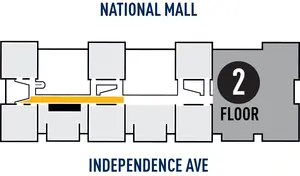An abundant supply of water on the Moon would make establishment of a self-sustaining lunar colony much more feasible and less expensive than presently thought.…the lunar surface is bombarded with water-rich objects such as comets, and scientists have suspected that some of the water in these objects could migrate to permanently dark areas at the lunar poles, perhaps accumulating to useable quantities. These suspicions appear to be correct.”—Paul D. Spudis, Clementine deputy chief scientist,“Ice on the Bone Dry Moon,” December 21, 1996.
Clementine
In 1994 the United States returned to the Moon for the first time since Apollo 17, more than twenty years before. The Clementine spacecraft, sponsored by the Department of Defense’s (DoD) Strategic Defense Initiative Organization with support from the Naval Research Laboratory and NASA, reflected the new cost-conscious 1990s. With a “cheaper, better, faster” philosophy, the mission’s primary purpose was to evaluate the performance of commercial “off the shelf” sensors and components under space conditions. Its secondary purpose was science, primarily related to mapping. The mission, though, produced a surprise:T The detection of ice embedded deep in a crater of the Moon’s south pole astounded the public and sparked intense debate among scientists.
Like the miner's daughter in the song, “My Darlin’ Clementine,” its instruments determined the variety of rock types on the Moon and then was “lost and gone forever.” Remarkably, Clementine went from the drawing board and into space in less than two years with a cost of under 100 million dollars, a bargain for space probes.
The Clementine spacecraft took off on 25 January 1994 from the West Coast launch complex at Vandenburg Air Force Base, California, and achieved lunar insertion on 21 February. Lunar mapping took approximately two months, but as the mission began a new phase on 7 May 1994, ground controllers signaled a spacecraft thruster to fire. Instead of cutting off at the designated time,it used up all its fuel andft left the spacecraft revolving at about 80 RPM. This made the planned continuation of the mission, a flyby of the near-Earth asteroid 1620 Geographos, impossible.
Clementine used seven distinct experiments to collect scientific data about the Moon: a UV/Visible Camera, a Near Infrared Camera, a Long Wavelength Infrared Camera, a High Resolution Camera, two Star Tracker Cameras, a Laser Altimeter, and a Charged Particle Telescope. An S-band transmitter allowed communications and tracking by engineers on Earth. Its advanced cameras recorded approximately 1.5 million images of over 99.9 percent of the Moon's surface, including laser radar measurements that enabled the creation of a more detailed topographical map of the lunar surface than ever possible before.
The acquisition of multi-spectral imagery proved a boon to science. The late 1996 revelation from scientists that data returned by Clementine indicated that ice may exist from an asteroid crash at the Moon’s South Pole reenergized lunar science. Scientist working with the Clementine data, led by chief project scientist Gene Shoemaker, asserted that a patch of probable ice about 25 feet thick and the diameter of a small pond might well exist on the South Pole. They constructed a mosaic of some 1,500 images of the lunar South Pole, revealing a depression named the South Pole-Atkin Basin estimated as four billion years old and some 1,500 miles wide. By far the deepest impact crater in the solar system, this area never saw the sun and gave off data readings suggestive of large concentrations of ice. Since it always remains less than -230°C, scientists thought it a perfect icy storehouse for water brought by comets to the Moon. Lunar geologist Eugene M. Shoemaker quipped that “This is the place on the Moon where you would go to get ice for your cocktail.” Excitement over this discovery spurred the team developing Lunar Prospector, a small, spin-stabilized craft sent to “prospect” the lunar crust and atmosphere for minerals, water ice, and certain gases in 1998.
The potential of ice on the Moon remains controversial. Scientists are divided over its existence. Imagery from Lunar Prospector seemed to confirm Clementine’s data of lunar ice, but when the spacecraft crashed into the presumed icebed on 31 July 1998 at the end of its mission, it yielded no confirming evidence that any water, frozen or otherwise, might be on the Moon. "It certainly would have been nice to find some sort of lunar skating rink, or thick layers of ice, but it looks like it's just not there," said Bruce Campbell of the Smithsonian Institution's Center for Earth and Planetary Studies. The jury is still out.
The object in the NASM collection is an engineering model of Clementine transferred from the Naval Research Laboratory, Washington, D.C.




